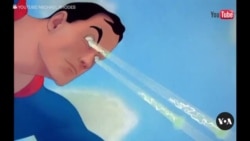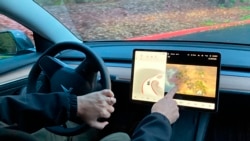ບັນດານັກຄົ້ນຄວ້າໃນລັດ ຄາລິຟໍເນຍ ແມ່ນກຳລັງເຮັດວຽກເພື່ອເຮັດໃຫ້ລົດທີ່ຂັບເຄື່ອນດ້ວຍຕົວມັນເອງມີຄວາມປອດໄພຂຶ້ນ ໂດຍການເຮັດໃຫ້ມັນເຫັນອ້ອມແຈມູມຕ່າງໆໄດ້. ແມັດ ດິບໂບ ມີລາຍງານສຳລັບລາຍການ LogOn ໃນອາທິດນີ້, ເຊິ່ງ ພຸດທະສອນ ຈະນຳລາຍລະອຽດມາສະເໜີທ່ານໃນອັນດັບຕໍ່ໄປ.
ການແນມເຫັນຜ່ານກຳແພງ ແລະ ສິ່ງກີດຂວາງຕ່າງໆ ຄັ້ງນຶ່ງເຄີຍເປັນຄວາມສາມາດທີ່ໃຊ້ສຳລັບພະເອກໃນຮູບເງົາ ຫຼື ກາຕູນເທົ່ານັ້ນ.
ແຕ່ຕອນນີ້ ກຸ່ມນັກຄົ້ນຄວ້າຢູ່ມະຫາວິທະຍາໄລ ສແຕນຝອດ ແມ່ນກຳລັງໃຊ້ການສະເທືອນຂອງແສງເລເຊີເພື່ອຖ່າຍພາບວັດຖຸຕ່າງໆທີ່ກ້ອງແນມບໍ່ເຫັນ.
ມັນເຮັດວຽກດ້ວຍການສະທ້ອນແສງອອກຈາກພື້ນຜິວທີ່ຢູ່ອ້ອມແອ້ມ, ເຊັ່ນກຳແພງ.
ທ່ານ ກໍດອນ ເວັດສໄຕນ໌, ຮອງສາສະດາຈານຢູ່ມະຫາວິທະຍາໄລ ສແຕນຝອດ ກ່າວວ່າ “ມັນມີແຫຼ່ງຂອງແສງ, ມັນມີເລເຊີ, ແລະ ມັນຈະເປັ່ງການສະເທືອນສັ້ນໆຢູ່ຫຼັງກຳແພງອອກມາ. ດັ່ງນັ້ນ, ເຄື່ອງເຊັນເຊີແມ່ນບໍ່ສາມາດເຫັນວັດຖຸໂດຍກົງ. ແຕ່ໜ່ວຍວັດຄວາມເຂັ້ມຂອງແສງທີ່ວ່ານີ້ ຈະຕຳໃສ່ວັດຖຸທີ່ຖືກປິດບັງຢູ່ ແລະ ໜ່ວຍວັດແທກຄວາມເຂັ້ມຂອງແສງຈຳນວນນຶ່ງນີ້ຈະກະຈາຍກັບມາຄືນ, ກັບມາຈົນເຖິງກ້ອງ.”
ທ່ານ ເວັດສໄຕນ໌ ກ່າວວ່າດ້ວຍການວັດແທກຄວາມຍາວຂອງເວລາທີ່ໜ່ວຍວັດແທກຄວາມເຂັ້ມຂອງແສງໃຊ້ເພື່ອສົ່ງກັບຄືນມາຫາກ້ອງນັ້ນ, ລະບົບດັ່ງກ່າວຈະສາມາດພິຈາລະນາຮູບຮ່າງຂອງວັດຖຸທີ່ຖືກປິດບັງຢູ່.
ເທັກໂນໂລຈີດັ່ງກ່າວ ອາດຖືກໃຊ້ເທື່ອທຳອິດເພື່ອເສີມຂະຫຍາຍລະບົບຖ່າຍພາບ LiDAR ຂອງລົດທີ່ຂັບເຄື່ອນດ້ວຍຕົນເອງ ເພື່ອເຮັດໃຫ້ມັນສາມາດເຫັນສິ່ງແວດລ້ອມຂອງມັນໄດ້ຫຼາຍຂຶ້ນ.
ທ່ານ ກໍດອນ ເວັດສໄຕນ໌ ກ່າວວ່າ “ມັນສາມາດເຫັນທາງໜ້າໄດ້ໄກອອກໄປ. ມັນສາມາດເຮັດໃຫ້ການຕັດສິນໃຈດີຂຶ້ນ ແລະ ຮອບຄອບກວ່າເກົ່າ. ພວກເຮົາບໍ່ຢາກໄດ້ລົດທີ່ແນມເຫັນສິ່ງທີ່ມະນຸດພວກເຮົາເຫັນເທົ່ານັ້ນ. ພວກເຮົາຢາກໃຫ້ມັນມີຄວາມປອດໄພຂຶ້ນກວ່າເກົ່າ.”
ການປະຕິບັດການຄົ້ນຫາ ແລະ ກູ້ໄພແມ່ນໂອກາດນຶ່ງທີ່ອາດຈະຖືກນຳໃຊ້.
ທ່ານ ກໍດອນ ເວັດສໄຕນ໌ ກ່າວວ່າ “ຄິດ ກ່ຽວກັບ ແຜ່ນດິນໄຫວ. ຄືທ່ານຮູ້, ຄົນແມ່ນຖືກຝັງຢູ່ກ້ອງຊາກຫັກພັງ. ຖ້າມັນມີຊ່ອງຫວ່າງແນວໃດແນວນຶ່ງ, ແລະ ພວກເຮົາກໍສາມາດທີ່ຈະຍິງແສງເລເຊີເຂົ້າໄປໃນນັ້ນ, ພວກເຮົາສາມາດທີ່ຈະສແກນພາບສິ່ງແວດລ້ອມສາມມິຕິຂອງພາກສ່ວນຈຸດເກີດເຫດທີ່ຖືກປິດຢູ່ ໄດ້ຢ່າງວ່ອງໄວ ແລະ ເບິ່ງວ່າ ມັນມີຄົນທີ່ຕ້ອງການຄວາມຊ່ວຍເຫຼືອຢູ່ໃນນັ້ນບໍ່.”
ສິ່ງທ້າທາຍທີ່ໃຫຍ່ທີ່ສຸດທີ່ກຸ່ມດັ່ງກ່າວ ກຳລັງປະເຊີນກໍແມ່ນການຄັດຕອງເອົາ ໜ່ວຍວັດແທກຄວາມເຂັ້ມຂອງແສງທີ່ມາຮອດກ້ອງຖ່າຍຮູບ ເພື່ອສ້າງພາບຂອງວັດຖຸນຶ່ງນັ້ນ.
ຄວາມສຳເລັດດັ່ງກ່າວໄດ້ມາພ້ອມກັບຂັ້ນຕອນວິທີນີ້.
ແຕ່ການນຳເອົາລະບົບນີ້ມາປະຕິບັດໃຊ້ຈະຕ້ອງອາໄສຄວາມກ້າວໜ້າທາງດ້ານເທັກໂນໂລຈີທີ່ຍັງບໍ່ໄດ້ເກີດຂຶ້ນເທື່ອ.
ທ່ານ ກໍດອນ ເວັດສໄຕນ໌ ກ່າວວ່າ “ມັນຍັງມີສິ່ງທ້າທາຍສອງສາມຢ່າງໃນຕໍ່ໜ້າ. ແຕ່ຂ້າພະເຈົ້າຄິດວ່າ ສິ່ງທີ່ພວກເຮົາສາມາດເຮັດກໍແມ່ນສະແດງໃຫ້ເຫັນຄວາມເປັນໄປໄດ້ຂອງຄວາມຄິດນີ້.”
ອະນາຄົດອາດແມ່ນໃກ້ຈະເກີດຂຶ້ນແລ້ວ.
ອ່ານລາຍງານນີ້ເປັນພາສາອັງກີດ
Seeing past walls and obstacles was once an ability reserved for superheroes.
Now a research team at Stanford University is using laser light pulses to image objects that are out of sight of a camera.
It works by bouncing light off surrounding surfaces, such as a wall.
“There’s a light source, there’s a laser, and it emits a short pulse that travels into the scene. It hits a visible part of the wall here. It gets scattered behind the wall. So, the sensor cannot see the object directly. But some of these photons hit the hidden object and some of these photons scatter back, all the way back to the camera.”
Wetzstein says by measuring the length of time the photons take to return to the camera, the system can determine the shape of the hidden object.
The technology might first be used to enhance the LiDAR imaging systems of autonomous vehicles to let them see more of their environment.
“It can see farther ahead. It can make better and more robust decisions. ((CUTAWAY: animated car sends out laser pulses)) We don't want the car just to see what we as humans see. We want them to be way more safe.”
Search and rescue operations are another potential use.
“Think about an earthquake. You know, people are buried under rubble. If there's any kind of opening, and we could just shoot a laser in there, we could quickly scan the 3D environment of the hidden part of the scene and see if there are any people in there that need help.”
The biggest challenge facing the team was filtering through all the photons arriving at the camera to reconstruct an object’s image.
The breakthrough came with this algorithm.
But putting the system to practical use will depend on technical advances yet to happen.
“There are still a few challenges ahead. But I think what we've been able to do is demonstrate the feasibility of this idea.”
The future may be just around the corner.







ຟໍຣັມສະແດງຄວາມຄິດເຫັນ